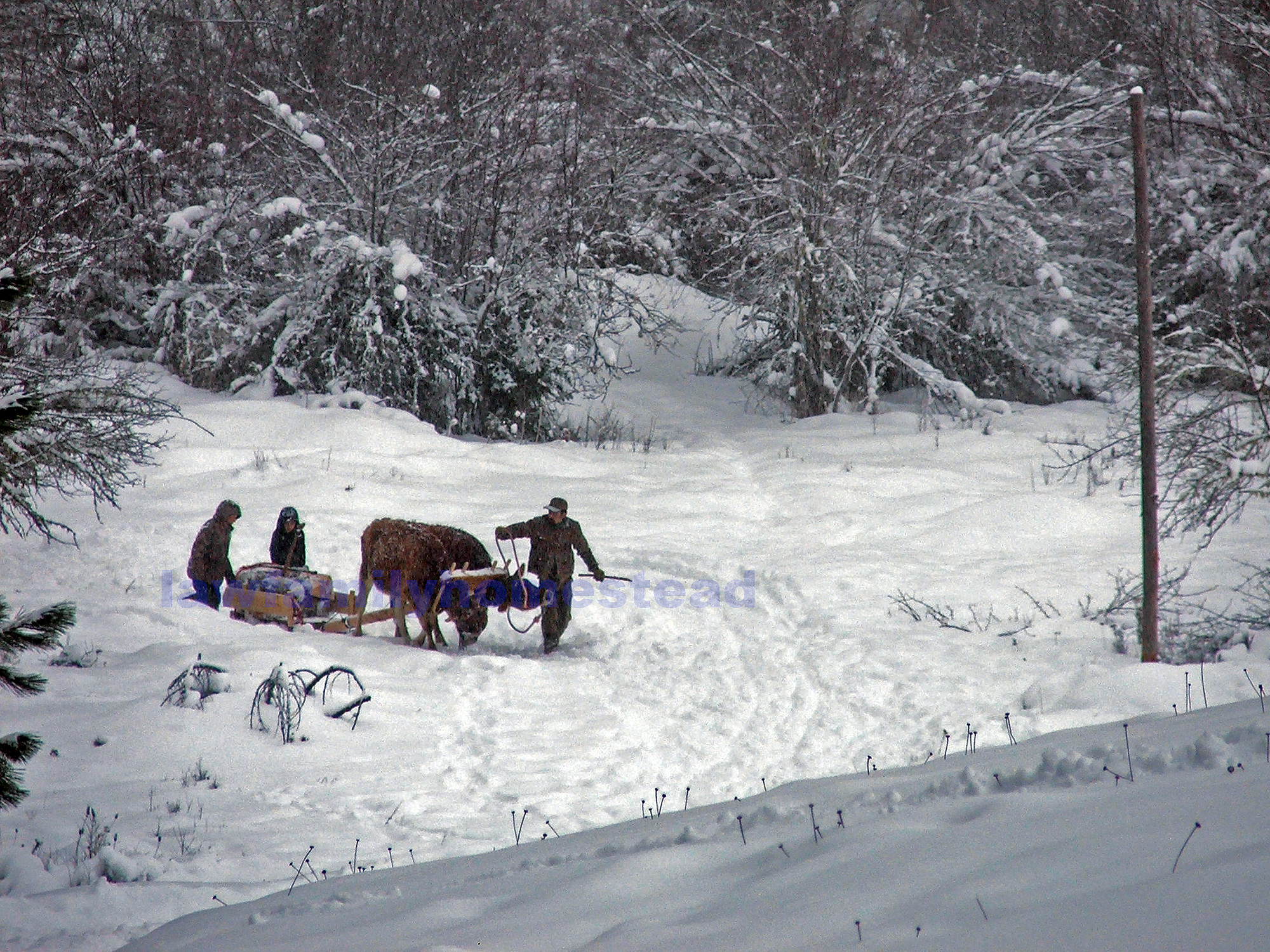Stepping Up Training
Two years after we moved to Idaho, in 2015, our county and the few surrounding counties had a record wildfire season. We had lightening caused fires surrounding us. At one point we evacuated for a few days, as the fire came within a mile and half of our place on one side burning directly toward us at eight miles per hour. The long and short of that year is, we decided a little fire mitigation on our place would go a long way toward us being able to fight any future fires that might start. Utilizing the timber removed during our fire mitigation we were able to build our hand-hewn log dairy barn.
We have continued removing logs and brush this winter as we train our ox team. And, according to our research, logging with oxen was historically done in the winter.
A load of firewood hauled up the hill from our woodlot area. Kit and the boys have slowly worked the team up to heavier loads as they became conditioned to the work. Here they have about 14 pieces of half wet firewood weighing roughly 250 pounds.
Drew Conroy, in his book OXEN: A Teamster's Guide to Raising, Training Driving, & Showing says: "A team of oxen is hard to beat when it comes to simple logging with minimal investment of money and training. For a part-time farmer or the owner of a small woodlot who needs to move firewood or thin a stand of trees, logging with oxen is appropriate, cost-effective and fun."
Getting ready to haul another load of firewood a quarter mile up hill to the driveway and around to the house.
It's hard to get a picture that really shows the grade the oxen have to pull. But there is something to be said about taking time to condition your animals. When these guys pulled the hill with just a couple pieces of firewood for the first time they were panting pretty hard. Now they have worked up to almost 500 pounds on the sled coming up the hill at a pace that makes the men trot keeping up with them. And they aren't breathing heavy at the top when they are stopped for a rest. Kit took the relascope out the other day and shot the grade on this part of the climb, and the oxen are pulling a 14 percent grade for about 100 yards out of the creek bottom.
From Drew Conroy's book again: "Cattle cleared the New England forests of large virgin timber in the 1600s and 1700s, and in many areas continued to be used in the woods well into the 1900s. With little outdoor farm work, many colonial farmers became lumbermen during the winter, their farm teams transformed into woods teams."
Coming up the next grade of 7 percent for 200 yards, through the gate to the driveway, and then a 5 percent drop to the house and wood pile. "Oxen were slow, steady, and less valuable than horses, and well suited to the difficult and dangerous work of logging. Even when an ox was injured, the loss was not total because the animal could be used for beef."
After a few weeks of working the sled hauling firewood, the guys had their sights on pulling out whole logs across the creek instead of packing it out by hand in rounds.
The unbroken trail through which the oxen will plow their way to their next work assignment. The few times I broke through the snow, I went in above my knee. It's deep down here!
Author Robert Pike, in Tall Trees, Tough Men, describes both the ox and the logging camps at the turn of the 20th Century in New England: "Before the days of the horses, a team of three yoke of oxen, hitched in tandem, was ordinarily used to haul logs to the river. It took a skillful teamster about two months to break a green team."
Our oxen didn't seem to have much trouble breaking trail. Just plowed their way through methodically. Where horses might be jumping and plunging as they lost footing and sank in the deep snow.
"Many current New England ox teamsters log part-time, using oxen for small-scale forest thinning operations or to haul their own firewood . . . they are less likely to shy from chainsaws, heavy machinery, falling trees, and deep snow or mud." From Drew Conroy's book OXEN.
Here the oxen are contemplating their first-ever creek crossing. I was ready with my camera in case there were some exciting moments, but alas, they ambled across without any trouble.
"During cooler winter months they compare favorably with horses and mules. In summer their pace will become slower than usual, because of their inability to sweat and thereby to dissipate body heat." Drew Conroy's book OXEN.
CW is in charge of setting chokers on the logs and hooking up the logging chain to the iron ring on the yoke.
Second creek crossing hauling a small 16-foot log, the guys eventually had the team crossing by themselves due to the fact that it was kind of tight quarters leading them across and the water was over their boot tops.
Up the creek bank, with no problem, just a bit more muscle.
After a short rest stop, the oxen were ready for the trip to the landing. They moved right along as if they had been doing it all their life. This was also their first time on a chain. We've been using a solid pole until now, to teach them they can't step over and to move away from the pole and chain between them.
Taking a breather at the landing area. These are dead pine and fir logs so they aren't as heavy as the eastern hardwood or green timber. Depending on the diameter, we are cutting the logs anywhere from eight to 16 feet long.
From here Kit will saw the logs into firewood size pieces, and larger pieces will be split by hand with a maul. They are then loaded on the sled for the trip up to the house.
Out and headed for the landing.
"The basic requirements for working in the woods are a yoke, a team willing to work, and a chain about 12 to 15 feet long, with a slip hook on one end and a grab hook on the other." Drew Conroy - OXEN.
Once the team gets the log moving they keep moving! If you want to keep up, you'd better run!
"Animals as young as six months old may be used in the woods, but for only a few hours at a time hauling small-diameter eight to 12 foot poles for firewood. Yearlings may be expected to work most of an eight hour day provided they get appropriate breaks and plenty of feed and water. A more mature team may be expected to work a full eight to 10-hour day once they are used to the work." Drew Conroy - OXEN.
Coming back for another log. CW holding up the chain to keep them from getting tangled in it in the deep snow.
Of course things aren't always picture perfect. Here the team has managed to get themselves in a bind. Thankfully oxen are methodical in their movements. Think of a bulldozer, they don't move fast but they can do a lot of damage at a slow speed. Oxen may have been the precursor to the bulldozer.
But over all our ox team is progressing with their training at a very good rate. This is one of the last loads of firewood they hauled up before we got a couple big snowstorms. This load weighed out at 430 pounds of firewood and gear, plus the 100 pound sled weight.



















